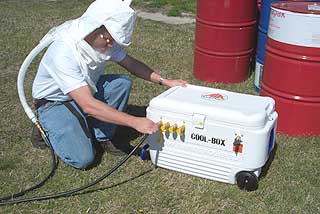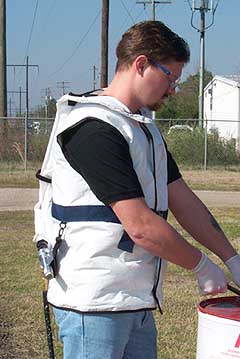|
Subscribe / Renew |
|
|
Contact Us |
|
| ► Subscribe to our Free Weekly Newsletter | |
| home | Welcome, sign in or click here to subscribe. | login |
Construction
| |

July 13, 2000
How to keep 'kool' when it's hot
Journal Staff Reporter
Welcome to summer in the Pacific Northwest. Although it may be partly-cloudy and cool in our area of Puget Sound, a quick trip to the other side of the mountains could show you sunshine and temperatures above 90 degrees.
And, if you’re working on a construction site, it only gets hotter.
According to the Occupational Safety and Health Administration, working in extreme heat conditions, especially on jobs that require protective clothing, can lead to heat stress, possibly causing dangerous medical conditions including heat exhaustion and heat stroke, as well as heat-induced rashes, fatigue and fainting.

|
Keeping cool is an important safety factor, says Dave Angelico, president and owner of Air Systems International in Chesapeake, Va. For 16 years, his company has been known for its breathing-air products on construction and manufacturing sites. More recently, Air Systems has developed products designed to keep workers cool in hot conditions.
One of the company's products, the Cool-Box, was created at the request of workers at the Hanford Nuclear Site in Eastern Washington. "They’re working in the desert over there, in about 110 to 120 degrees," Angelico says. The workers wanted a cheep way to cool the air in their full-body chemical suits. "They’re going to die if they don’t get some cool air in there. They asked us to build something for them."
Designed like an ice machine, the Cool-Box is basically an Igloo ice chest that acts as a pass-through for air coming from a mobile air compressor. "You throw ice in the cooler, and warm air is passed through the cooler, through coils, and blown into the back of their suits," he says. "Anybody can hook up any kind of respirator and get cool breathing air."
For about $695, the Cool-Box works for about four hours, suppling air at about 50 degrees for up to four people. Angelico says it works well for workers who need to wear safety suits or breathing hoods for painting or sandblasting.
Another product -- Air Systems' first in its line of personal cooling products -- is the Kool-Vest. Used with an air line adapter, the Kool-Vest is made to apply cool air directly to the chest and back. The vest is made of a double-layered PVC scrim material with an adjustable cooling ring for the head and face.
"It's used more predominantly by industrial manufacturing plants," Angelico says. "Any kind of area where there are warm conditions. We do a lot with the steel mills and foundries. It's very hot ... and you can't air-condition a steel mill."
For those who don't want to be tied up to an air line, Air Systems makes a Kool-Vest with internal pockets to hold special chemical cooling packs. The packs are different than your typical freezer cold-pack or simple bag of ice cubes. "The chemical changes from liquid to solid at about 50 degrees... It actually holds the cold at 50 degrees, instead of 32 degrees," Angelico says. "You don't actually chill the guy's skin, which would do more harm than good."

|
The cost of the Kool-Vest is about $195. Angelico says they will soon come out with a new, less-expensive Kool-Vest for wider applications. "We're talking about a low-cost vest for $99, just for the construction industry," he says. The new product would serve the road worker laying asphalt or flagman guiding traffic in the hot sun, "where heat exhaustion can be a major problem."
The chemical packs will keep their cool for two to four hours, and take about 20 to 30 minutes to recharge. "They don't have to be frozen," Angelico says. The packs can easily recharge in a tub of ice or ice water.
Air Systems is also coming out with a Cap Cooler for hard hats using the same cold-pack principle. Velcro tabs keep a cold pack secured in the hard hat's suspension strap.
Personal cooling devices like these make the heat a little more bearable and are more effective than alternative methods -- like pouring a bucket of ice cubes over your head.
Lisa Lannigan can be
reached by email or by phone
at (206) 622-8272.
Previous columns:
- AGC members are 'best supporting actors' for new Tacoma arts center, 07-06-2000
- Heating a home on two bits a day, 06-29-2000
- WSU offers design-build management degree, 06-22-2000
- Siding panels use gravity to keep the rain out, 06-15-2000
- Company has the poop for keeping birds away, 06-08-2000
- Creating a little desert indoors, 06-01-2000
- Living in a cardboard house, 02-24-2000
- $17 million emergency center spurred by fire training tower, 01-13-2000


